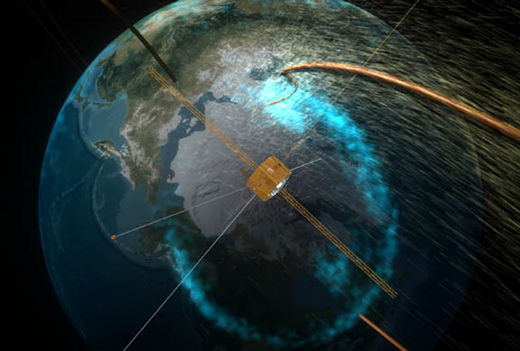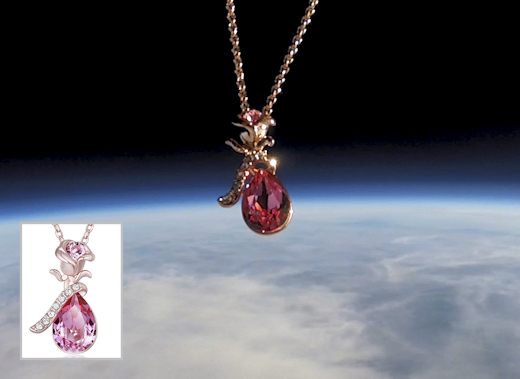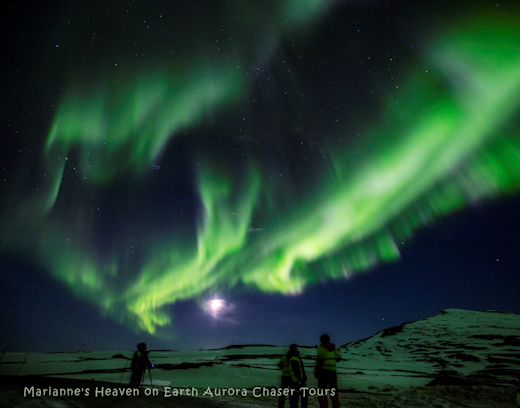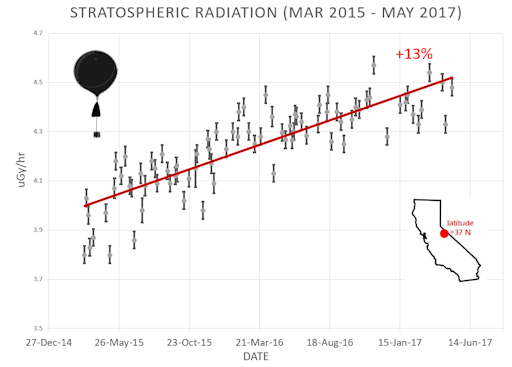Lights Over Lapland is excited to announce that we now have TWO aurora webcams covering nearly a 200° view of Abisko National Park in Sweden! Watch the auroras dance live, all season long here. | | |
LONG-DEAD NASA SPACECRAFT WAKES UP: Amateur astronomer Scott Tilley has a hobby: He hunts spy satellites. Using an S-band radio antenna in Roberts Creek, British Columbia, he regularly scans the skies for radio signals from classified objects orbiting Earth. Since he started 5 years ago, Tilley has bagged dozens of secret or unlisted satellites. "It's a lot of fun," he confesses.
Earlier this month, Tilley was hunting for Zuma--a secretive United States government satellite lost in a launch mishap on Jan. 8th--when a J-shaped curve appeared on his computer screen. "It was the signature of a lost satellite," he says, "but it was not Zuma."
In a stroke of good luck that has dizzied space scientists, Tilley found IMAGE, a NASA spacecraft that "died" more than 10 years ago.

An artist's concept of IMAGE flying over Earth's north pole.
Short for "Imager for Magnetopause-to-Aurora Global Exploration," IMAGE was launched in 2000 on a flagship mission to monitor space weather. Mapping the ebb and flow of plasma around Earth, IMAGE was able to watch our planet's magnetosphere respond almost like a living organism to blasts of solar activity, while its ultraviolet cameras took gorgeous pictures of Earth's global auroras.
"It had capabilities that no other spacecraft could match--before or since," says. Patricia Reiff, a member of the original IMAGE science team at Rice University.
IMAGE was in the 5th year of its extended mission on Dec. 18, 2005, when the spacecraft suddenly went silent. No one knows why, although suspicions have focused on a power controller for the spacecraft's transponder, which might have temporarily failed.
The one hope was a reboot: When IMAGE's solar-powered batteries drained to zero during a eclipse by the Earth, onboard systems could restart and begin transmitting again. "If revival occurs, the mission should be able to continue as before with no limitations," noted NASA's IMAGE Failure Review Board in their 2006 report.
A deep eclipse in 2007, however, failed to produce the desired result. "After that, we stopped listening," says Reiff.

Radio signals from IMAGE, detected by Scott Tilley on Jan. 20, 2018. [more]
That is, until Scott Tilley started looking for Zuma. "When I saw the radio signature, I ran a program called STRF to identify it," he says. Developed by Cees Bassa, a professional astronomer at the Netherlands Institute for Radio Astronomy, STRF treats Earth-orbiting satellites much like binary pulsars--deducing their orbital elements from the Doppler shifts of their radio signals. "The program immediately matched the orbit of the satellite I saw to IMAGE. It was that easy," says Tilley.
Sometime between 2007 and 2018--no one knows when--IMAGE woke up and started talking. Now, NASA has to find a way to answer.
"The good news is, NASA is working on a recovery plan," says Reiff. "UC Berkeley still has a ground station that was used for realtime tracking and control. They are scrambling to find the old software and see it they can get the bird to respond. Apparently there are data side lobes on the transmission, so that is a good sign."
Researchers would love to have IMAGE back. The spacecraft has a unique Big Picture view of Earth's magnetosphere and "its global-scale auroral imager would be fantastic for nowcasting space weather," says Reiff. "Fingers crossed!!"
This is a developing story. Stay tuned for updates.
Realtime Aurora Photo Gallery
VALENTINE'S DAY IS COMING: Nothing says "I Love You" like a Valentine's pendant from the edge of space. On Dec. 29, 2017, the students of Earth to Sky Calculus flew a payload-full of these 18k rose gold plated Valentine's pendants to the stratosphere onboard a high-altitude helium balloon:

The necklaces traveled alongside an array of cosmic ray sensors, which the students use to monitor deep-space radiation penetrating Earth's atmosphere.
You can have one for $169.95. Each glittering pendant comes with a greeting card showing the jewelry in flight and telling the story of its journey 36 km (118,110 feet) above the Sierra Nevada mountains of central California. Sales support the Earth to Sky Calculus cosmic ray ballooning program and hands-on STEM research.
Far Out Gifts: Earth to Sky Store
All proceeds support hands-on STEM education
SPOTLESS SUN SPARKS AURORAS: The sun has been spotless and quiet for 6 consecutive days. Nevertheless, auroras are dancing around the Arctic Circle. On Jan. 24th, "the lights were absolutely amazing, they blew me away!" reports Marianne Bergli, who sends this picture from Tromsø, Norway:

"Even with no solar storm, the view was unparalleled," she says.
What's going on? The answer is "Tromsø." The island city in Norway is located beneath our planet's persistent auroral oval, a ring-shaped region surrounding the north pole where the geomagnetic field guides solar wind particles down onto the upper atmosphere. This extraterrestrial rain may ebb, but it never stops. Inside the oval, sputtering auroras can suddenly blossom into magnificent sprays of green and purple light--no solar storms required.
We predict that the sun will be spotless at least 50% of the time in 2018 as the solar cycle plunges toward a deep minimum expected in 2019-2020. Arctic auroras, however, will continue. Browse the realtime photo gallery for sightings. Free: Aurora Alerts.
Realtime Aurora Photo Gallery
Realtime Space Weather Photo Gallery
Every night, a network of
NASA all-sky cameras scans the skies above the United States for meteoritic fireballs. Automated software maintained by NASA's Meteoroid Environment Office calculates their orbits, velocity, penetration depth in Earth's atmosphere and many other characteristics. Daily results are presented here on Spaceweather.com.
On Jan. 26, 2018, the network reported 12 fireballs.
(12 sporadics)

In this diagram of the inner solar system, all of the fireball orbits intersect at a single point--Earth. The orbits are color-coded by velocity, from slow (red) to fast (blue). [Larger image] [movies]
Potentially Hazardous Asteroids (
PHAs) are space rocks larger than approximately 100m that can come closer to Earth than 0.05 AU. None of the known PHAs is on a collision course with our planet, although astronomers are finding
new ones all the time.
On January 26, 2018 there were 1882 potentially hazardous asteroids.
 |
Recent & Upcoming Earth-asteroid encounters: | Asteroid | Date(UT) | Miss Distance | Velocity (km/s) | Diameter (m) |
| 2018 BQ5 | 2018-Jan-20 | 5.1 LD | 9.3 | 12 |
| 2018 BP3 | 2018-Jan-20 | 1.2 LD | 7 | 6 |
| 2018 BH3 | 2018-Jan-20 | 4.2 LD | 9.1 | 32 |
| 2018 BD5 | 2018-Jan-20 | 6.6 LD | 8.6 | 22 |
| 306383 | 2018-Jan-22 | 14.4 LD | 17.4 | 178 |
| 2018 AK12 | 2018-Jan-23 | 7 LD | 22.3 | 33 |
| 2018 BT1 | 2018-Jan-23 | 15.3 LD | 16.7 | 90 |
| 2018 AV11 | 2018-Jan-23 | 11.1 LD | 9.1 | 34 |
| 2018 AJ | 2018-Jan-23 | 4.7 LD | 5.6 | 42 |
| 2018 BG1 | 2018-Jan-24 | 10.9 LD | 7.3 | 28 |
| 2018 BP1 | 2018-Jan-24 | 19.2 LD | 8.2 | 44 |
| 2018 BA3 | 2018-Jan-24 | 3 LD | 8 | 21 |
| 2018 AL12 | 2018-Jan-26 | 8.1 LD | 19.6 | 37 |
| 2018 BM5 | 2018-Jan-26 | 4.8 LD | 9.1 | 12 |
| 2018 BU1 | 2018-Jan-27 | 3.1 LD | 11.3 | 44 |
| 2018 BQ | 2018-Jan-27 | 9.3 LD | 3.4 | 27 |
| 2018 AQ2 | 2018-Feb-02 | 13.4 LD | 17.4 | 132 |
| 2002 CB19 | 2018-Feb-02 | 10.5 LD | 15.6 | 36 |
| 2018 BN5 | 2018-Feb-03 | 15.9 LD | 9.4 | 23 |
| 2018 BG3 | 2018-Feb-03 | 11.9 LD | 14.1 | 60 |
| 2018 AH12 | 2018-Feb-04 | 5.3 LD | 5 | 15 |
| 276033 | 2018-Feb-04 | 11 LD | 34 | 646 |
| 2018 BL1 | 2018-Feb-09 | 16.5 LD | 20.3 | 75 |
| 2015 BN509 | 2018-Feb-09 | 12.9 LD | 17.7 | 257 |
| 1991 VG | 2018-Feb-11 | 18.4 LD | 2.1 | 7 |
| 2014 WQ202 | 2018-Feb-11 | 15.1 LD | 19.8 | 62 |
| 2016 CO246 | 2018-Feb-22 | 15.3 LD | 5.4 | 21 |
| 2017 DR109 | 2018-Feb-24 | 3.7 LD | 7.4 | 11 |
| 2016 FU12 | 2018-Feb-26 | 13.2 LD | 4.5 | 15 |
| 2014 EY24 | 2018-Feb-27 | 14.8 LD | 8 | 54 |
| 2015 BF511 | 2018-Feb-28 | 11.7 LD | 5.7 | 39 |
| 2003 EM1 | 2018-Mar-07 | 16.6 LD | 8 | 45 |
| 2017 VR12 | 2018-Mar-07 | 3.8 LD | 6.3 | 282 |
| 2015 DK200 | 2018-Mar-10 | 6.9 LD | 8 | 27 |
Notes: LD means "Lunar Distance." 1 LD = 384,401 km, the distance between Earth and the Moon. 1 LD also equals 0.00256 AU. MAG is the visual magnitude of the asteroid on the date of closest approach. | | Cosmic Rays in the Atmosphere |
Readers, thank you for your patience while we continue to develop this new section of Spaceweather.com. We've been working to streamline our data reduction, allowing us to post results from balloon flights much more rapidly, and we have developed a new data product, shown here:

This plot displays radiation measurements not only in the stratosphere, but also at aviation altitudes. Dose rates are expessed as multiples of sea level. For instance, we see that boarding a plane that flies at 25,000 feet exposes passengers to dose rates ~10x higher than sea level. At 40,000 feet, the multiplier is closer to 50x. These measurements are made by our usual cosmic ray payload as it passes through aviation altitudes en route to the stratosphere over California.
What is this all about? Approximately once a week, Spaceweather.com and the students of Earth to Sky Calculus fly space weather balloons to the stratosphere over California. These balloons are equipped with radiation sensors that detect cosmic rays, a surprisingly "down to Earth" form of space weather. Cosmic rays can seed clouds, trigger lightning, and penetrate commercial airplanes. Furthermore, there are studies ( #1, #2, #3, #4) linking cosmic rays with cardiac arrhythmias and sudden cardiac death in the general population. Our latest measurements show that cosmic rays are intensifying, with an increase of more than 13% since 2015:

Why are cosmic rays intensifying? The main reason is the sun. Solar storm clouds such as coronal mass ejections (CMEs) sweep aside cosmic rays when they pass by Earth. During Solar Maximum, CMEs are abundant and cosmic rays are held at bay. Now, however, the solar cycle is swinging toward Solar Minimum, allowing cosmic rays to return. Another reason could be the weakening of Earth's magnetic field, which helps protect us from deep-space radiation.
The radiation sensors onboard our helium balloons detect X-rays and gamma-rays in the energy range 10 keV to 20 MeV. These energies span the range of medical X-ray machines and airport security scanners.
The data points in the graph above correspond to the peak of the Reneger-Pfotzer maximum, which lies about 67,000 feet above central California. When cosmic rays crash into Earth's atmosphere, they produce a spray of secondary particles that is most intense at the entrance to the stratosphere. Physicists Eric Reneger and Georg Pfotzer discovered the maximum using balloons in the 1930s and it is what we are measuring today.
| | The official U.S. government space weather bureau |
| | The first place to look for information about sundogs, pillars, rainbows and related phenomena. |
| | Researchers call it a "Hubble for the sun." SDO is the most advanced solar observatory ever. |
| | 3D views of the sun from NASA's Solar and Terrestrial Relations Observatory |
| | Realtime and archival images of the Sun from SOHO. |
| | from the NOAA Space Environment Center |
| | fun to read, but should be taken with a grain of salt! Forecasts looking ahead more than a few days are often wrong. |
| | from the NOAA Space Environment Center |
| | the underlying science of space weather |
 | Reviews here can help you to pick up best memory foam mattresses. |
| | These links help Spaceweather.com stay online. Thank you to our supporters! |
| | | | | | |

